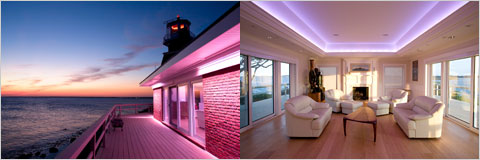Dean Kamen’s ”˜LED Nation’
By Eric A. Taub
 Dean Kamen’s home with LED lighting. (Photos: John Brandon Miller)
Dean Kamen’s home with LED lighting. (Photos: John Brandon Miller)![]() See the Slide Show
See the Slide Show
Dean Kamen always seems to be one or two steps ahead of the rest of us. He invented a wheelchair that climbs stairs, the Segway scooter, and a robotic prosthetic arm that moves based on thought, among other things.
Mr. Kamen also owns North Dumpling Island, a three-acre island off the Connecticut coast that he jokingly refers to as an independent nation. But now, it’s more than that ”” he calls it “the world’s first LED nation.”
Mr. Kamen wanted to take the entire place off the grid, producing his own power through wind and solar. But to do that, he had to reduce energy consumption. So he turned to LEDs, or light-emitting diodes.
With LED lighting typically using about one-fifth the power consumed by standard incandescent fixtures (and I have some LED bulbs in my home that use just one-tenth the wattage of an incandescent bulb), Mr. Kamen figured he could get the power usage down to an amount that would work.
Mr. Kamen tapped his long-time friend, Fritz Morgan, chief technology officer of Philips Color Kinetics for help. The two collaborated on removing all incandescent fixtures from Mr. Kamen’s home, the caretaker’s house and a guest house, replacing them with Color Kinetics products.
They included LED downlights (the kind that go in ceilings and shine down), undercabinet kitchen lights and exterior units to wash the outside walls in changing color patterns.
Mr. Morgan also installed a prototype of a reflector bulb (called a PAR38) that the company expects to bring to market sometime next year. As with a regular reflector bulb sold today, it is dimmable and has the same warm color temperature as an incandescent.
The result was, they cut the energy consumption used in the house by 70 percent. And of course, the bulbs won’t have to be changed for years. When you add in the power used for the exterior lights (the house was not previously lit outside), total energy consumption was reduced by 50 percent, enough to take the island off the grid.
Total average power used is 2,500 watts. If everything is ablaze inside and out, consumption peaks at 5,000 watts.
“We wanted to convince ourselves that the technology is ready to do this,” Mr. Morgan said. “This installation lets us see what works and what doesn’t.”
While this is great for Dean Kamen, he wants others to see it as well. This spring, the setup will be shown during a fund-raiser for FIRST, an organization started by Mr. Kamen to encourage young people to become involved in science and technology. Invitations have gone out to various luminaries.
While the look Philips created is fascinating, you will probably want to try this at home only if you’ve got an open-ended line of credit.
Although LED prices are dropping fast, right now, the technology is too expensive for residential use. The ColorBlast units used to illuminate the exterior pillars cost around $600 each (including a power supply), and Mr. Morgan used two per pillar. That is a dramatic reduction from 2001, when the unit cost $1,300 without a power supply, but still enough to stop most people in their tracks.
Recently, I accompanied a local lighting designer in Los Angeles as he created an imaginative exterior lighting project for an Architectural Digest home. To do the job right cost $60,000. The clients passed.

